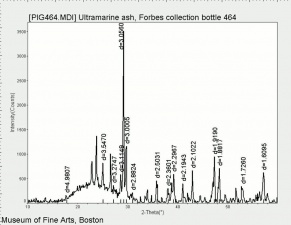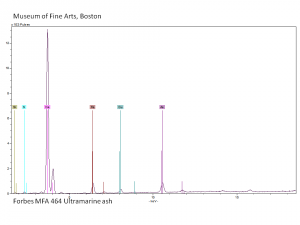Difference between revisions of "Ultramarine ash"
Jump to navigation
Jump to search
m (Text replace - "\[http:\/\/cameo\.mfa\.org\/materials\/fullrecord\.asp\?name=([^\s]+)\s(.*)\]" to "$2") |
|||
| Line 1: | Line 1: | ||
[[File:464 ultramarine ash2.jpg|thumb|Ultramarine ash]] | [[File:464 ultramarine ash2.jpg|thumb|Ultramarine ash]] | ||
== Description == | == Description == | ||
| − | + | [[File:Ultraash C100x.jpg|thumb|Ultramarine ash at 100x (visible light left; UV light right)]] | |
The end-product of the refining process used to produce [[ultramarine%20blue%2C%20natural|natural ultramarine blue]] pigment from [[lapis%20lazuli|lapis lazuli]]. Ultramarine ash contains small blue particles mixed with a large proportion of colorless materials, such as calcite and silicates. Ultramarine ash is a transparent blue-gray pigment that has been used for glazing. | The end-product of the refining process used to produce [[ultramarine%20blue%2C%20natural|natural ultramarine blue]] pigment from [[lapis%20lazuli|lapis lazuli]]. Ultramarine ash contains small blue particles mixed with a large proportion of colorless materials, such as calcite and silicates. Ultramarine ash is a transparent blue-gray pigment that has been used for glazing. | ||
| Line 10: | Line 10: | ||
[[[SliderGallery rightalign|PIG464.jpg~XRD|f464sem.jpg~SEM|f464edsbw.jpg~EDS|Slide7_F464.PNG~XRF]]] | [[[SliderGallery rightalign|PIG464.jpg~XRD|f464sem.jpg~SEM|f464edsbw.jpg~EDS|Slide7_F464.PNG~XRF]]] | ||
| − | == | + | == Risks == |
| − | |||
| − | |||
| − | |||
| − | |||
| − | |||
| − | |||
| − | |||
| − | |||
| − | |||
| − | |||
| − | == | + | * No significant hazards. |
| + | ==Physical and Chemical Properties== | ||
| − | + | * Discolors when exposed to weak acids or sulfur fumes. | |
| − | |||
| − | |||
| + | ==Resources and Citations== | ||
| − | + | * J. Plesters, "Ultramarine Blue, Natural and Artificial", ''Artists Pigments'', Volume 2, A. Roy (ed.), Oxford University Press: Oxford, 1993. | |
* Ralph Mayer, ''A Dictionary of Art Terms and Techniques'', Harper and Row Publishers, New York, 1969 (also 1945 printing) | * Ralph Mayer, ''A Dictionary of Art Terms and Techniques'', Harper and Row Publishers, New York, 1969 (also 1945 printing) | ||
Latest revision as of 09:45, 23 June 2022
Description
The end-product of the refining process used to produce natural ultramarine blue pigment from Lapis lazuli. Ultramarine ash contains small blue particles mixed with a large proportion of colorless materials, such as calcite and silicates. Ultramarine ash is a transparent blue-gray pigment that has been used for glazing.
Synonyms and Related Terms
mineral blue; Sander's blue; Saunder's blue; bleu cendres; vein stone
Risks
- No significant hazards.
Physical and Chemical Properties
- Discolors when exposed to weak acids or sulfur fumes.
Resources and Citations
- J. Plesters, "Ultramarine Blue, Natural and Artificial", Artists Pigments, Volume 2, A. Roy (ed.), Oxford University Press: Oxford, 1993.
- Ralph Mayer, A Dictionary of Art Terms and Techniques, Harper and Row Publishers, New York, 1969 (also 1945 printing)





